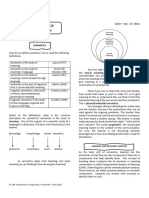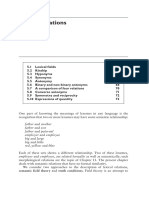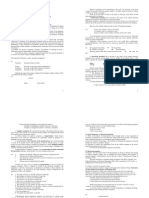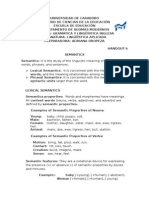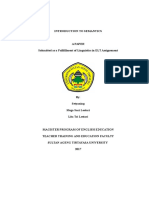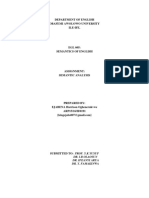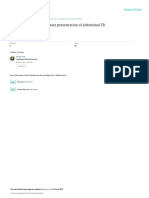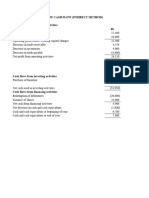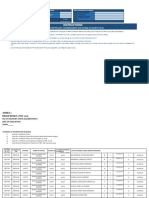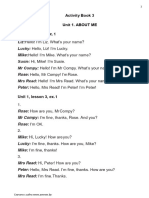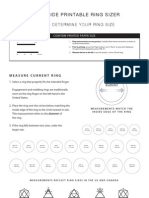ANSWER KEY Semantics: a coursebook
Unit 16 Study Guide and Exercises
Directions: After you have read Unit 16 you should be able to tackle the following questions to
test your understanding of the main ideas raised in the unit.
1. You should understand these terms and concepts from this unit:
dictionary vs. encyclopedia
types of dictionary
a linguistic semanticists's dictionary
an ordinary dictionary-writer's dictionary
semantic primes
technical (theoretical) predicates
2. What kind of information about words is found in a typical (i.e. collegiate) dictionary?
The word's pronunciation, its grammatical category (part of speech),
statements meant to characterize its meaning, and usually information about
the word's history (etymology).
3. What does it mean to say that all dictionary definitions are interconnected? How is this
related to the various kinds of sense relations we studied in units 10 and 11? Is this sort of
interconnectedness desirable? Why or why not?
Most words in the dictionary are related to each other in some way due to the
fact that they share components of meaning with other words. The sense
relations we studied in units 10 and 11 (synonymy, antonymy, hyponymy, etc.)
represent some of the most important kinds of these interrelated aspects of
meaning. Interconnectedness of meaning is helpful in organizing the extremely
complex lexical information in structured ways.
4. Why is a certain degree of circularity necessary in dictionary entries? How do dictionaries
occasionally try to avoid such circularity?
Because definitions are characterized in terms of paraphrases containing other
words in the language. Circularity is prevalent, because a meaning paraphrase
of one word might contain one or more words whose own meaning
paraphrases could contain the word originally being defined. Semantic primes,
undefined technical terms (sometimes from another language) are sometimes
used to avoid circularity. These are sometimes called technical predicates.
5. How do the goals, style of approach, etc. of a semanticist dictionary-writer differ from those of
an ordinary dictionary-writer? How are they the same?
See the unit for details. In brief, a linguistic semanticist's dictionary differs from
an ordinary dictionary as follows: it's less complete; interconnections are
explicitly based on interrelations between the senses of predicates; it might
leave some terms undefined (semantic primes); it uses a logical framework and
notations where applicable; it focuses on sense relations in the everyday
language; it tries to be more precise than an ordinary dictionary. Ordinary
dictionaries are more likely to try to define everything; interconnections are not
explicitly based on sense relations; they don't use logic; they have a bias
toward educated usage; they are less precise.
www.cambridge.org/hurford
© James R. Hurford, Brendan Heasley and Michael B. Smith 2007
�ANSWER KEY Semantics: a coursebook
6. What is the main interest of the semanticist dictionary-writer?
To characterize the sense relations between predicates.
7. What are technical predicates (such as *sibling) and what is the advantage in proposing
them? Try to think of some additional examples not mentioned in the text which meet the criteria
proposed in this unit for such predicates.
Technical terms typically not occurring in the everyday language that are used
in order to capture natural classes of predicates. Additional examples will vary.
8. For each of the following sets of predicates indicate the one which does NOT belong to the
same natural class as the others and WHY it does not belong. Then indicate the common
conceptual element(s) the others share. Note that in some cases this element of meaning may be
quite abstract. The predicate that does not belong is marked in boldface, followed by the
reason why. It is conceivable that other answers are possible.
a. pine, elm, ash, oak, dandelion, sycamore, fir
Dandelions are flowers; the other items are trees.
b. table, stone, book, glass, ship, soup, tree
Soups are liquids; the other items are solids.
Another possibility: trees are living entities; the others are not alive.
c. computer, paper, idea, lamp, car, highway, tractor
Ideas are abstract; the other items are concrete.
d. walk, skip, run, jump, ride, swim, hop
Swimming is done in water; the other activities are done on land.
Another possibility: riding requires a vehicle; the others do not.
e. ask, tell, whisper, say, speak, talk, converse
Whispering is done in a lower than usual voice; the others are usually
done at a normal volume.
f. alive, tall, asleep, dead, married, pregnant
Tall is a gradable adjective; the others are binary.
9. In what ways do ordinary dictionaries lack the sort of precision required by a linguistic
semanticist? Give an example of how this lack of precision can lead to difficulties, especially for
someone who does not know the actual meanings of the words being looked up. How can such
lack of precision be remedied (or can it)?
Answers will vary. They should be modeled on the discussion of man in this
unit.
10. Why do you think most ordinary dictionaries usually leave out reference to the kinds of sense
relations we studied in units 10 and 11? Why are they included in the linguistic semanticists's
dictionary?
www.cambridge.org/hurford
© James R. Hurford, Brendan Heasley and Michael B. Smith 2007
�ANSWER KEY Semantics: a coursebook
The kinds of sense relations we have studied are typically omitted from
ordinary dictionaries, because they are so obvious to the native speakers who
usually use the dictionaries. They are included in the linguistic semanticist's
dictionary for the sake of completeness.
11. Do you think it is reasonable (or even possible) for the linguistic semanticist to try to omit
encyclopedic information from his dictionary? Why or why not? How does this issue relate to
the distinction between analytic and synthetic sentences?
Because the linguistic semanticist is primarily interested in accounting for word
meanings, non-linguistic facts about the world (encyclopedic information) are
thought to be less important. This relates to the analytic/synthetic distinction in
that analytic information is closely tied to the literal core sense of a word, and
is thus more likely to be included in a linguist's dictionary, whereas synthetic
information is more closely tied to the context in which the word is used, and is
less likely to be included in the linguist's dictionary.
www.cambridge.org/hurford
© James R. Hurford, Brendan Heasley and Michael B. Smith 2007







